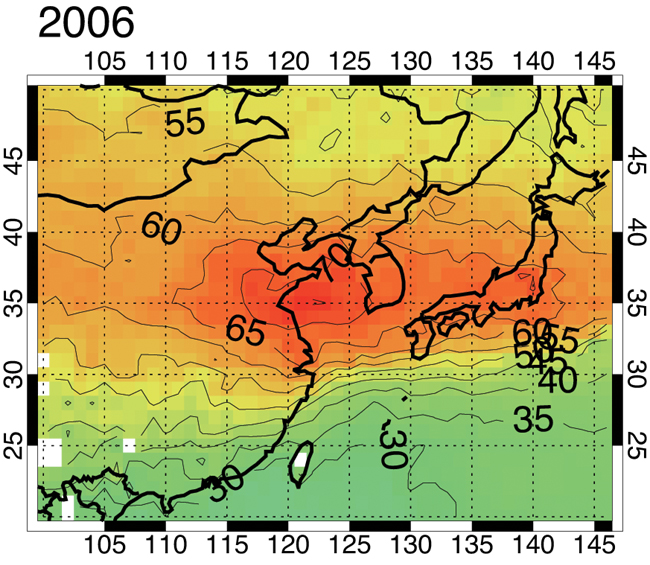Atmospheric Minor Species- Finding diamonds in the sand
 [Release: October, 2015]
[Release: October, 2015]
Professor Sachiko Hayashida
Environmental Sciences Course
Department of Chemistry, Biology, and Environmental Science
Faculty of Science
Nara Womens University
My main research interest is studying atmospheric minor species. The structure of the global atmosphere as dry air is composed of approximately 80% nitrogen (N2) and 20% oxygen (O2). Together, these gases account for approximately 99% of the atmosphere. The remaining 1% includes many other types of gases known as atmospheric minor species. Carbon dioxide (CO2) and methane (CH4) are well known as important anthropogenic greenhouse gases, while ozone (O3) and nitrogen dioxide (NO2) are also known to be atmospheric pollutants. All these gases are atmospheric trace components. While they are present in very low quantities in the atmosphere, they exert a large impact on the environment. So, what does low signify? The globally averaged concentration of atmospheric carbon dioxide is approximately 390 ppm (parts per million), or 0.039% of the atmosphere, while the average concentration of methane is around 1800 ppb (parts per billion) or just 0.00018%. Despite their very small quantities, these components are, in fact, the chief drivers of global warming.
I analyze such trace components using data from satellite observations. Generally speaking, observing the chemical composition of the earths atmosphere is extremely difficult. However, recent technological advances have made it possible to observe a variety of these components. As a result, we have come to understand much more about the earths atmosphere. Land-surface observations from space tell us "what exists there" but observations of atmospheric species may tell us "what are people doing there". For example, careful investigations of nitrogen dioxide (NO2) data collected by satellites have shown that concentrations above Tokyo tend to fall on Sundays, perhaps because of fewer NO2-emitting vehicles are on the roads and less factories are working on a non-work day. Similarly, the outstanding decrease in NO2 concentrations above Beijing during its Olympic Games is well known to have been the result of traffic controls. Other species observed include carbon monoxide, which is released during forest fires, as well as methane, which is believed to escape from oil and natural gas fields under production.
In my recently published paper, I identified high concentrations of ozone in the lower altitudes of the atmosphere above China (below an altitude of 3 km), via satellite. Tropospheric ozone is considered an atmospheric polluting oxidant. The amount of ozone near the surface is usually only a small percentage of the total amount; 90% of the total ozone resides in the stratosphere (at altitudes between 10 km and 40 km) and approximately 10% resides in the troposphere (below 10 km). Therefore, vertical discrimination of ozone in the lower troposphere through satellite-borne measurements has been challenging. However, substantial progress has been made with respect to this difficult problem. In collaboration with Harvard University, we were able to identify very small ozone signals in the lower atmosphere, via satellite. We were also able to clearly identify high concentrations of ozone occurring at the beginning of summer above central China (figure). I believe that the distribution of ozone, as shown in the figure, provides definitive evidence of cross-border pollution moving from China to Japan. I am presently conducting research with the Meteorological Research Institute to develop quantitative model simulations and comprehensive analyses to verify this.
Investigating atmospheric minor species is not limited to atmospheric pollutants in a narrow sense but is relevant to studies of greenhouse gases. Carbon dioxide is not the sole culprit when it comes to global warming. From a comparison of the influence of different gases on global warming using a parameter known as radiative forcing, carbon dioxide is estimated to account for around 60% of the total impact. The remainder is due to the existence of methane and other gases that are prevalent in even smaller quantities than carbon dioxide. Research is being conducted on some of the gases that do not remain in the atmosphere for long; these gases are known as short-lived climate pollutants (SLCP). I focus on methane, in particular, as most methane is produced by biological activity. This biological activity makes methane difficult to evaluate quantitatively, and there is still much that we do not know. Since 2015, I have been leading a research project on methane emissions in South Asia, as a representative of the Improvement of Methane Emission Estimate from South Asia using GOSAT and Development of an Emission Mitigation ProposalEproject, a project of the Ministry of the Environments Environment Research and Technology Development Fund. Methane is released from rice farming and livestock, making agricultural activities in developing countries a major source of global emissions. The Japanese satellite, GOSAT (affectionately known as IbukiE was the first satellite in the world to measure greenhouse gases and leads the world in carbon dioxide and methane measurements. With this research activity, I hope to promote the use of methane data taken from the Ibuki satellite. In December 2016, I gave a speech on Ibuki observations at the OECD Green Growth and Sustainable Development Forum, held in Paris. It is my fervent wish that the findings of my research be used for the improvement of the global environment.
Atmospheric minor species, though small in quantity, certainly punch above their weight in terms of their impact on the environment. As a researcher, it is my hope that my work may also have a meaningful impact in the world.
*Short Lived Climate Pollutants

A Recent Publication Related to this Reserch
Observation of ozone enhancement in the lower troposphere over East Asia from a space-borne ultraviolet spectrometer S. Hayashida, X. Liu, A. Ono, K. Yang, and K. Chance Atmos. Chem. Phys., 15, 9865-9881, 2015
http://www.atmos-chem-phys.net/15/9865/2015/
doi:10.5194/acp-15-9865-2015

